| |
Windows 2000 Professional Reviewed
I've been writing extensively about Windows 2000 Professional since
over a year and a half, dating back to the release of Windows NT 5.0
Beta 2 in August 1998. For that reason, I won't reiterate my many
observations about the development of this OS here. Instead, I'll
point you to the following reviews and articles that I wrote during
the development of Windows 2000 Professional:
Windows
NT 5.0 Technical Reviewer's Workshop review (August 1998)
A look at Microsoft's press roll-out for Windows NT 5.0, which would
soon become known as Windows 2000.
Windows NT 5.0 Workstation Beta 2 reviewed
(August 1998)
Beta 2 was the first release to include a shadow under the mouse
cursor, personalized menus, My Network Places, customizable toolbars
in My Computer, a Hardware Wizard, a Device Manager, and a whole lot
more.
Windows 2000 Professional Beta 3 review
(April 1999)
Beta 3 was the first "feature complete" release of Windows
2000 and as such, I evaluated it based on Microsoft's then-final
goals for the product: Easiest Windows yet, the Best of Windows 98,
the Power of NT, and Lower TCO.
What's new in Windows 2000 Release
Candidate 1 (July 1999)
A look at the changes in RC1, including a new graphical fading drag
effect, offline notifications in the shell, broader hardware
support, a general simplification of the user interface, and more.
What's new in Windows 2000 Release
Candidate 2 (September 1999)
A look at the last major beta release of Windows 2000; changes
include a network disconnect cue, simplification of My Network
Places, the latest version of Internet Explorer (5.01), and more.
The Road to Gold: A look at the development of
Windows 2000 (December 1999)
An amazing and unduplicated look at the development of Windows 2000,
from its roots as an upgrade to Windows NT 4.0 in 1996 to its
victorious release in Early 2000.
Now that we've got the historical
perspective out of the way, let's take a look at the latest business
mobile and desktop operating system from Microsoft. Note that I said
"business": Windows 2000 is not for home users of
any stripe. If you want to play games, use the latest 3D video
cards, scanners, or digital cameras, or need backwards compatibility
with DOS, then Windows 2000 is not for you. Rather, Windows 2000 is
designed specifically for mobile and desktop machines running in
businesses. Find this controversial? Tough. And get used to it: If
you have to ask, Windows 2000 probably isn't for you.
And it requires some heady hardware: A Pentium II 300 with 128 MB of
RAM, as far as I'm concerned. Anything less would be frustrating.
For more information about whether Windows 2000 is right for you,
please read my article, Should
you upgrade to Windows 2000? And stop sending me
machine specs. Like I said, if you have to ask, it's probably not
for you.
But Windows 2000 Professional is a mighty achievement for those that
can and should run it. It's user interface is far simpler and
refined than that of Windows 98 and Windows NT 4.0. Subtle graphical
improvements such as a shadow under the mouse cursor and graceful
menu transitions make Windows 2000 seem more elegant than its
forefathers. And, of course, you get all of the improvements that
time and money can provide, with increased hardware and software
compatibility, improved stability, and the security we've come to
expect from NT. If you can run Windows 2000, it will offer you the
best of both worlds.
Compared to Windows 98
I've written an extensive comparison of Windows 2000 and Windows 98
called Top 10 reasons Windows 2000 is
better than Windows 98 which explains the major differences
between the two OSes from a user's perspective. But of course, the
differences are much deeper than that: Because Windows 2000 is built
on the NT 4.0 code base, it features none of the DOS-based code
bloat that Windows 9x has been carrying around all of these years.
Conversely, it also features none of the hardware and software
compatibility that we've come to expect from Windows 98.
Aside from user interface differences, then, the main differences
between Windows 2000 can be summed up in terms of compatibility,
security, and reliability. Windows 98 offers the ultimate in
hardware and software compatibility. If it's out there, Windows 98
will work with it and Windows 2000 won't, not unless its on the HCL
(for hardware) or the list of compatible applications (for
software). But Windows 98 sacrifices security and reliability for
compatibility, crashing early and often. Windows 2000, on the other
hand, almost never crashes. I've been running Windows 2000
continuously since Beta 3 and I have never seen a blue screen or
hard crash that required the system to be rebooted. In fact, I never
even reboot the machine at all, unless it's for testing purposes:
The system just stays up, running 24x7 continuously. At night, the
power management features kick in and it wakes up each morning when
I'm ready to get to work. Doing this with Windows 98 is but a dream.
The point here is, if you can run it on Windows 2000, it will run
forever, with no reboots or crashes. So the computing experience
with Windows 2000, as it were, is head and shoulders above Windows
98. But if you want to use the latest USB scanners or play Quake III
Arena, Windows 98 is a better solution.
Compared to Windows NT 4.0 Workstation
Windows NT 4.0 is another story. NT, like Windows 2000, is
reliable and secure. But NT offers none of the graphical niceties of
Windows 2000, and doesn't even come close to 2000 in terms of
hardware and software compatibility. If you're running Windows NT
4.0 and use a system with acceptable hardware, the 2000 upgrade is a
no-brainer. Over its three and a half year lifetime, NT 4.0 has been
upgraded with six major service packs, hundreds of hot fixes, three
major Web browser releases, and an Option Pack. Rather than install
all this software, along with the nightmare of determining which
order they must be installed in, Windows 2000 gives you all of this
and more, right out of the box. And because future fixes to Windows
2000 can be slipstreamed into the OS install point, you'll never
have to mess with service pack stupidity again.
And if you're interested in running the latest hardware--ATA-66
controllers, USB, IEEE-1394 ("Firewire"), or
whatever--Windows 2000 is, in many cases, you're only choice. Dual
monitor support is there, without any vendor-specific hacks. Power
Management. The list goes on and on.
Now, in NT's defense, it does have some advantages over Windows
2000. Though it's hard to believe I'm even saying this, NT 4.0 is
far lighter and quicker than Windows 2000. It boots far more
quickly. And because the underlying system is so much simpler, it's
easier to master the thing. With Windows 2000, I think we're looking
at a few years at least before any of the NT experts out there can
truly wrap their minds around this new OS. There's just so much new
stuff in there. Still, unless you're stuck with a Pentium-level
system and less than 128 MB of RAM, Windows 2000 is almost surely
the way to go. It's a huge improvement over NT 4.0.
Conclusions
I've been using Windows 2000 for so long now, it's hard for me
to even wrap my mind around the things that are new, when compared
to previous releases. Whenever I have to go back and use Windows 98
or Windows NT 4.0, however, I appreciate the changes in Windows
2000, almost all of which are definitely for the better. Though the
transition from a flat NT 4.0 domain system to Microsoft's horribly
convoluted Active Directory is going to cause problems for many
companies, Windows 2000 Professional shines in such an environment.
Offline Files and Folders allow you to take the network on the road,
so to speak, giving you transparent access to resources that would
normally require manual synchronization, for example. But Windows
2000 Pro will also work nicely in a legacy NT domain or workgroup,
affording its users the latest user interface and simplicity
enhancements. And for individual users with modem connections to the
Internet, the simplicity improvements, along with the security and
reliability of 2000, are just too good to ignore.
Though rebel operating system Linux seems to be getting an unfair
share of news lately, let's be serious: The refined and elegant
Windows 2000 Professional is in a different league altogether from
the rough and tumble "roll your own UI" of Linux. There's
just no comparison. We can crack jokes about the 35 million lines of
code (often misstated into the 50 million range), the three-plus
year development time, and the monopoly that is Microsoft, but the
truth is out there: Windows 2000 Professional is, quite simply, the
best desktop operating system that's ever been created. It might not
be for you, if you need to run games or multimedia hardware, but
that situation will improve over time. If you can run Windows 2000,
do so. It's the best there is.
And here's the most compelling evidence that Windows 2000
Professional is the best there is, as far as I'm concerned: I use
it. I use it every single day. I've tested, again and again, various
versions of Windows 98 (including the soon-to-be-released Millennium
Edition), Windows NT 4.0, and, on a revolving basis, the top three
distributions of Linux, and I keep going back to Windows 2000
Professional. On my laptops and desktops, I run Windows 2000. (I
also run Windows 2000 Server on my multi-processor server.) Windows
2000 Professional is the best of the lot. It's that simple.
|
|
Screenshots
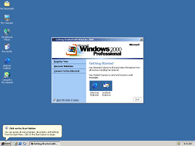
The Windows 2000 desktop is simpler than Windows 98 and Windows NT
4.0.
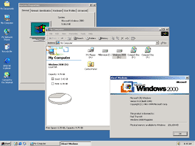
Icons in My Computer have been trimmed down to display only the most
important items.
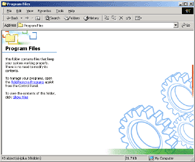
Soft-blocks, such as this screen in Program Files, prevent users
from inadvertently deleting important files.
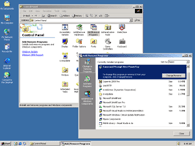
A new HTML-based Add/Remove Programs in Control Panel makes it easy
to configure the applications on a Win2K system.
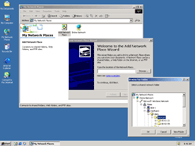
FTP sites, network shares, and other resources can be easily added
to your Network Places.
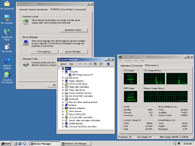
Finally, a true Device Manager. And Windows 2000, unlike Windows 98,
supports multiple CPUs.
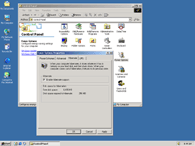
Windows 2000 Pro supports the widest range of power management
settings in the industry, making it ideal for mobile users.
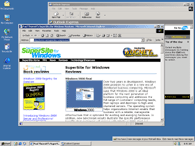
Web browsing, email, and live Internet Messaging are all available
in Win2K.
|

